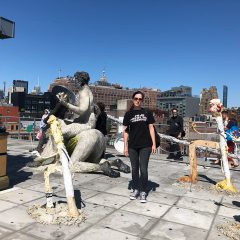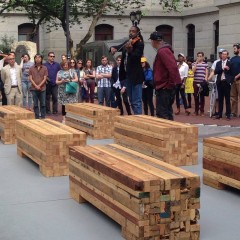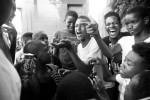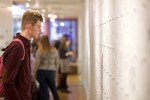This week’s Weekly includes my review of the ICA’s Spring Shows (all except Soft Sites in the Project Space). Here’s the link to the art page and below is the copy with some extra pictures. And here’s Libby’s post on the ICA shows. Here’s my flickr set with shots of Zoe and others and the art at the opening last month.
Ode de Cologne
German spaces collide with Philly faces at the ICA.
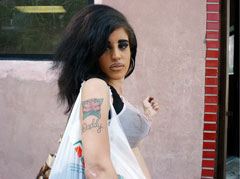
Strauss’s image Daddy Tattoo. For a harrowing update on the woman in this photo, whose name is Monique, see Strauss’s blog post.WARNING: It might make you cry.
Germany meets Philadelphia at the Institute of Contemporary Art this season, with a group show about art in Cologne, and photographs by German artist Candida Höfer running up against Zoe Strauss‘ Philly-centric photography in the ICA’s ramp space.
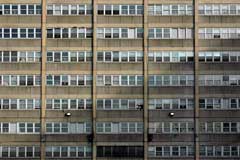
Cabrini Green, Woman Leaning by Strauss.
It’s a fair fight. Strauss, the local favorite and Whitney Biennial star, pulls together a three-part project (slide show, wall and window
installation) that more than holds its own. Walking up the ramp and into Strauss’ little bit of Philly is a journey worthy of Dante. Moving slowly upward, face-to-face with the photographer’s images of crack smokers, prostitutes and the poor is like moving through hell with a guide. If you haven’t seen Strauss’ work in person, see it here, where the intimacy of the photographer’s loving vision is matched by the cramped intimacy of the ramp that forces you to be up close with people you might cross the street to avoid.
[Ed note: We at artblog are Strauss maniacs as you know. For more about Strauss see the index with links to other posts.
And this late-breaking news from Rob Matthews, Artblog pal and Philadelphia Art Museum employee, Strauss’s work is included the just-opened Philadelphia Museum of Art photography show Summer Vacation curated by PMA Photography Curator, Kate Ware. That show’s in the Julien Levy (ie ramp) Gallery on the first floor. And here’s confirmation on Strauss’s blog where she tells us the photo in that show is the great one of a kid doing a summersault on a pile of mattresses in the street.]
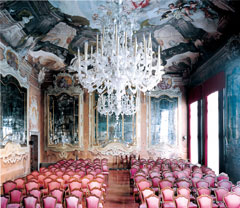
Candida Hofer’s Ca’Dolfin.
As for the Germans, Candida Höfer‘s large color photos of social spaces like cafes, libraries and concert halls-all devoid of people-are theatrical, gorgeous and full of love. Höfer makes her public and semipublic spaces heroic, although there’s nothing particularly heroic about any of them. The artist conveys the idea of time with her combination of perfect, mostly symmetrical framing and a focus on repeating shapes like chairs, pillars, windows or archways.
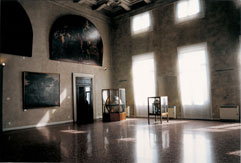
Candida Hofer’s Museo Civico
But it’s time stopped, not time moving. The works are pregnant with expectation, and that sense of tension lifts Hofer’s photos from mere descriptions of architectural space to creations of spaces as characters themselves. They’re like movie stars in glam shots. Höfer loves these spaces, and while many of them would be outstanding rooms to stand in (like the Campo Santo Pisa or the Museo Civico Vicenza), somehow I think if I go to any one of them I’ll be let down, as I probably would be if I saw Madonna on a street corner with a shopping bag on her arm.
Höfer was a student of famed photographers Bernd and Hilla Becher, known for their taxonomic photographs of abandoned industrial sites like coke and coal processing plants. Höfer-and Strauss too-is making taxonomies as well. But unlike the Bechers, Höfer’s and Strauss’ works don’t brood. The photos are like a lover’s embrace, full of emotion and warmth.
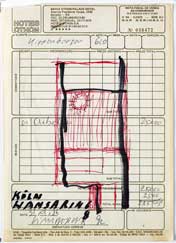
Martin Kippenberger drawing on a hotel restaurant receipt from the Cologne show. Actually the Kippenberger drawings in the case are copies of the originals which are too fragile to travel.
You won’t find much warmth in “Make Your Own Life: Artists in and out of Cologne,” a group exhibit with works by 29-plus artists from Cologne and elsewhere. It’s a patchwork show with only passing visual interest. But the catalog musings about Cologne in the 1980s and early ’90s (a hedonistic scene in which the cult of the artist reigned, yet little art was produced) raise an important issue: art stardom. There’s definitely value in thinking about artists as art stars, and how dangerous that is when played out as it was in Cologne. Cologne burned out, and its artists dispersed or died. Regionalism is over, the market dominates, and in a post-9/11 global art world, even an art star has to take their shoes off to pass through airport security. So much for stardom-let’s make some work.
Candida Höfer: “Architecture of Absence”; Zoe Strauss: “Ramp Project”; “Make Your Own Life: Artists in and out of Cologne”
Through July 30. Institute of Contemporary Art, 118 S. 36th St. 215.898.5911.


